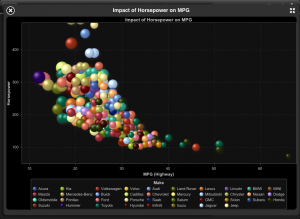The Data Visualization Charting 101 series explores different tools to visualize data. Check out other posts to see which data visualization is right for you.

What comes to mind when you hear the word bubbles? I think of the fact that it’s getting warmer outside and prime time for my toddler to dance around in the yard while I blow bubbles. In addition to being a children’s activity, bubbles are used in data visualization by organizations looking for insights to make better decisions.
In a nutshell, bubble plots are simply a variation of a scatter plot in which the markers are replaced with bubbles.
Bubble plot basics
- Each bubble represents an observation
- The location of the bubble represents the value for two measured axes
- The size of the bubble represents the value for a third measure
When should you use a bubble plot?
These plots are useful for data sets with dozens to hundreds of values or when the values differ by several orders of magnitude. You can also use a bubble plot when you want specific values to be represented by different bubble sizes. Animated bubble plots are a good way to display changing data over time.
Think your scatter plot needs bubbles? Learn more about which chart works best for different data sets by downloading the white paper, Data Visualization Techniques.
Also, you may want to check out this brief video on bubble plots in SASVisual Analytics. You can get your hands on SASVisual Analytics at the "Software Cafe" at SAS Global Forum, April 28-May 1, in San Francisco.
